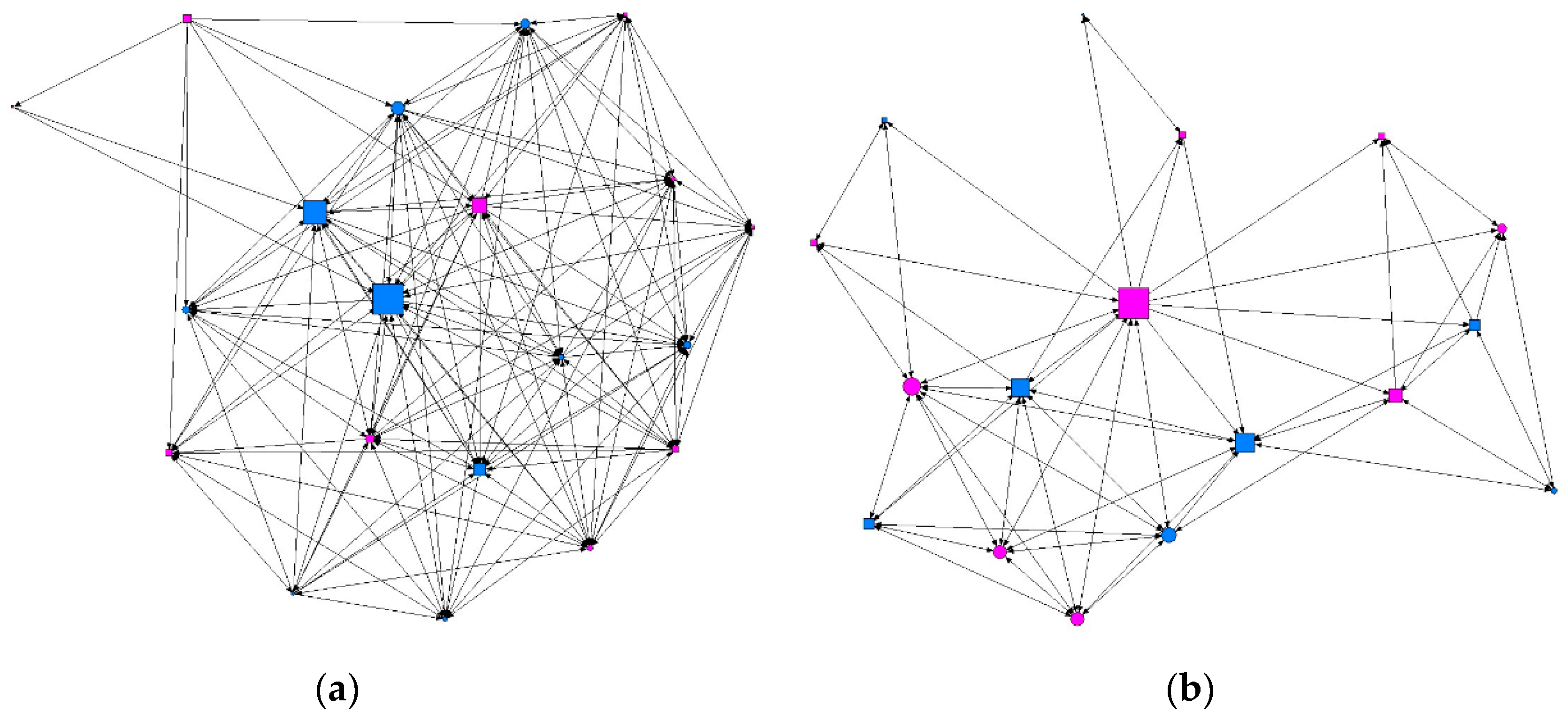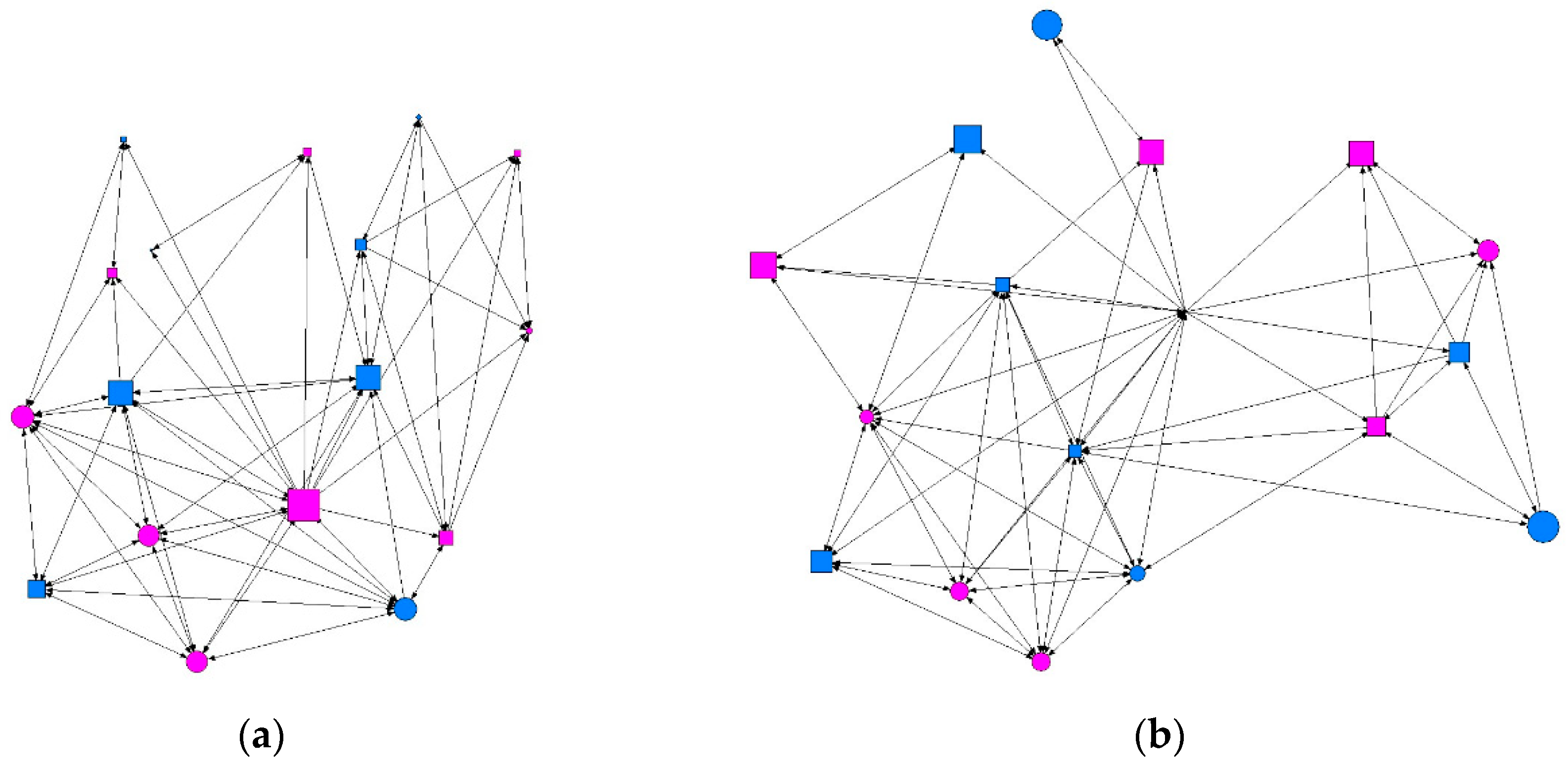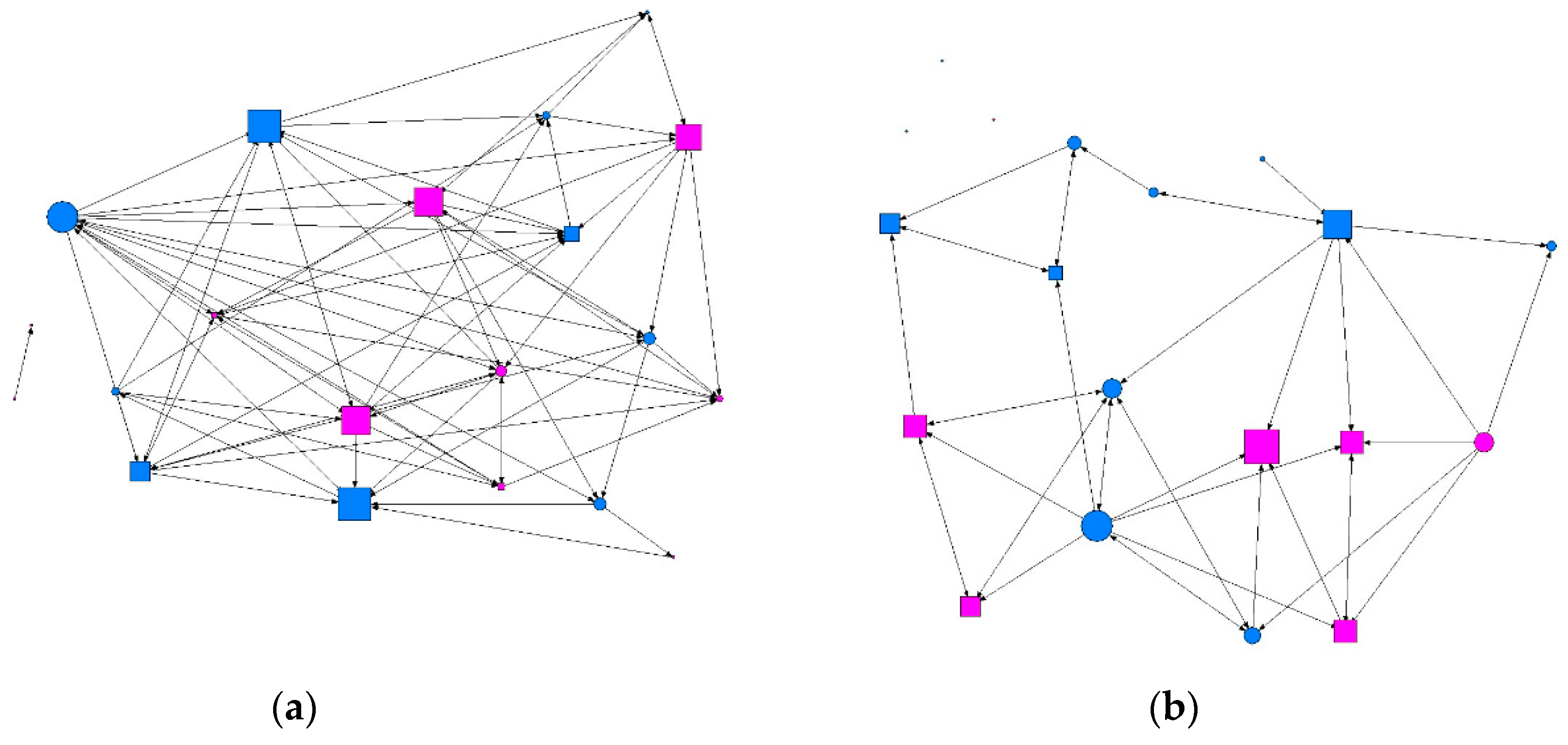The Influence of Adolescents’ Social Networks on Alcohol Consumption: A Descriptive Study of Spanish Adolescents Using Social Network Analysis
Abstract
1. Introduction
- To determine adolescents’ pattern of consumption in relation to at-risk use of alcohol and other substances.
- To analyze the structural position of adolescent at-risk alcohol users within their peer microsystem in the class.
2. Materials and Methods
2.1. Participants
2.2. Instruments
2.3. Procedure
2.4. Data Analysis
3. Results
3.1. Pattern of Consumption
3.2. Structural Position in the Class and Alcohol Consumption
4. Discussion
5. Conclusions
Limitations
Author Contributions
Funding
Conflicts of Interest
References
- Room, R.; Babor, T.; Rehm, J. Alcohol and public health. Lancet 2005, 365, 519–530. [Google Scholar] [CrossRef]
- WHO. Alcohol. Available online: http://www.who.int/es/news-room/fact-sheets/detail/alcohol (accessed on 12 July 2018).
- Zeigler, D.W.; Wang, C.C.; Yoast, R.A.; Dickinson, B.D.; McCaffree, M.A.; Robinowitz, C.B.; Council on Scientific Affairs, American Medical Association. The neurocognitive effects of alcohol on adolescents and college students. Prev. Med. 2005, 40, 23–32. [Google Scholar] [CrossRef] [PubMed]
- Miller-Day, M.A.; Alberts, J.; Hecht, M.L.; Trost, M.R.; Krizek, R.L. Adolescent Relationships and Drug Use; Psychology Press: Nueva York, NY, USA, 2014. [Google Scholar]
- WHO. Regional Office for Europa. Available online: http://www.who.int/about/regions/euro/es (accessed on 12 July 2018).
- Ministerio de Sanidad, Consumo y Bienestar Social. Declaración Los jóvenes y el alcohol. Conferencia Ministerial Europea de la OMS: Stockholm, Sweden, February 2001. Available online: https://www.msssi.gob.es/ciudadanos/proteccionSalud/adolescencia/alcohol/declaEsto.htm (accessed on 12 July 2018).
- Observatorio Español de la Droga y las Toxicomanías (OEDT); Delegación Nacional del Gobierno para el Plan Nacional sobre Drogas (DGPNSD); Ministerio de Sanidad, Servicios Sociales e Igualdad (MSSSI). Encuesta sobre uso de drogas en enseñanzas secundarias en España (ESTUDES), 2014–2015. Available online: http://www.pnsd.msssi.gob.es/profesionales/sistemasInformacion/sistemaInformacion/encuestas_ESTUDES.htm (accessed on 12 July 2018).
- Frías, J.; Torres, J.M.; Rodríguez, R.; Ruiz, E.; Ortega, E. Effects of acute alcohol intoxication on growth axis in human adolescents of both sexes. Life Sci. 2000, 67, 2691–2697. [Google Scholar] [CrossRef]
- Observatorio Español de la Droga y las Toxicomanías (OEDT). Informe Annual 2011: El Problema de la Drogodependencia en Europa. Available online: http://www.emcdda.europa.eu/system/files/publications/969/EMCDDA_AR2011_ES.pdf (accessed on 12 July 2018).
- Hernández-Serrano, O.; Gras Pérez, M.E.; Font-Mayolas, S. Consumo de drogas y participación deportiva en estudiantes universitarios de ciencias de la salud y el deporte. Health Addict. Salud Drogas 2018, 18, 61. [Google Scholar] [CrossRef]
- Oficina de las Naciones Unidas contra la Droga y el Delito. Informe Mundial sobre Drogas 2016. Available online: https://www.unodc.org/doc/wdr2016/V1604260_Spanish.pdf (accessed on 12 July 2018).
- Becoña, E.; Martínez, U.; Calafat, A.; Juan, M.; Fernández-Hermida, J.R.; Secades-Villa, R. Parental styles and drug use: A review. Drug Educ. Prev. Policy 2012, 19, 1–10. [Google Scholar] [CrossRef]
- Mason, W.A.; Kosterman, R.; Haggerty, K.P.; Hawkins, J.D.; Redmond, C.; Spoth, R.L.; Shin, C. Gender moderation and social developmental mediation of the effect of a family-focused substance use preventive intervention on young adult alcohol abuse. Addict. Behav. 2009, 34, 599–605. [Google Scholar] [CrossRef] [PubMed]
- Laespada, M.T.; Arostegi, E.; Iraurgui, J. Factores de Riesgo y Protección Frente al Consumo de Drogas: Hacia un Modelo Explicativo del Consumo de Drogas en Jóvenes de la CAPV; Instituto Deusto de Drogodependencias, Universidad de Deusto: Bilbao, Spain, 2004. [Google Scholar]
- Brown, R.L.; Matousek, T.A.; Radue, M.B. Legal-agestudents’ provision of alcohol to under age college students: An exploratory study. J. Am. Coll. Health 2009, 57, 611–618. [Google Scholar] [CrossRef] [PubMed]
- Komro, K.; Maldonado-Molina, M.; Tobler, A.; Bonds, J.; Muller, K. Effects of home access and availability of alcohol on young adolescents’ alcohol use. Addiction 2007, 102, 1597–1608. [Google Scholar] [CrossRef] [PubMed]
- Teunissen, H.A.; Kuntsche, E.; Scholte, R.H.J.; Spijkerman, R.; Prinstein, M.J.; Engels, R.C.M.E. Friends’ drinking norms and male adolescents’ alcohol consumption: The moderating role of performance-based peer influence susceptibility. J. Adolesc. 2016, 53, 45–54. [Google Scholar] [CrossRef] [PubMed]
- Berndt, T.J.; Keefe, K. Friends’ influence on adolescents’ adjustment to school. Child. Dev. 1995, 66, 1312–1329. [Google Scholar] [CrossRef] [PubMed]
- Yañez, A.; Leiva, A.; Gorreto, L.; Tejera, E.; Torrent, M. El instituto, la familia y el tabaquismo en adolescentes. Adicciones 2013, 25, 253–259. [Google Scholar] [CrossRef] [PubMed]
- Fernández, M.A.; Dema, S.; Fontanil, Y. La influencia de los roles de género en el consumo de alcohol: estudio cualitativo en adolescentes y jóvenes en Asturias. Adicciones 2018, unpublished. [Google Scholar] [CrossRef] [PubMed]
- Ennett, S.T.; Bauman, K.E.; Hussong, A.; Faris, R.; Foshee, V.A.; Cai, L.; Durant, R.H. The peer context of adolescent substance use: Findings from social network analysis. J. Res. Adoles. 2006, 16, 159–186. [Google Scholar] [CrossRef]
- Lozares Colina, C. La teoría de redes sociales. Pap. Rev. Sociol. 1996, 48, 103–126. [Google Scholar] [CrossRef]
- Wasserman, S.; Faust, K. Social Network Analysis: Methods and Applications; Cambridge University Press: Cambridge, UK, 1994; Volume 8, ISBN 978-0521387071. [Google Scholar]
- Valente, T.W.; Hoffman, B.R.; Ritt-Olson, A.; Lichtman, K.; Johnson, C.A. Effects of a social-network method for group assignment strategies on peer-led tobacco prevention programs in schools. Am. J. Public Health 2003, 93, 1837–1843. [Google Scholar] [CrossRef] [PubMed]
- Loureiro Varela, E.; Fernández Peña, R. Análisis de redes sociales (ARS) y epidemiología. In Concectados Por Redes Sociales; Del Fresno García, M., Paunero, D.S., Márques Sánchez, P., Eds.; UOC: Barcelona, Spain, 2014; pp. 277–294. [Google Scholar]
- Ennett, S.T.; Bauman, K.E. Peer group structure and adolescent cigarette smoking: A social network analysis. J. Health Soc. Behav. 1993, 34, 226–236. [Google Scholar] [CrossRef] [PubMed]
- Bauman, K.E.; Ennett, S.T. On the importance of peer influence for adolescent drug use: Commonly neglected considerations. Addiction 1996, 91, 185–198. [Google Scholar] [CrossRef] [PubMed]
- Kobus, K. Peers and adolescent smoking. Addiction 2003, 98, 37–55. [Google Scholar] [CrossRef] [PubMed]
- Moody, J.; Brynildsen, W.D.; Osgood, W.; Feinberg, M.E.; Gest, S. Popularity trajectories and substance use in early adolescence. Soc. Netw. 2011, 33, 101–112. [Google Scholar] [CrossRef] [PubMed]
- Kadushin, C. Introduction to Social Network Theory; Oxford University Press: Boston, MA, USA, 2004. [Google Scholar]
- Moody, J.; White, D.R. Structural cohesion and embeddedness: A hierarchical concept of social groups. Am. Sociol. Rev. 2003, 68, 103–127. [Google Scholar] [CrossRef]
- Scott, J. Social Network Analysis; Sage: Newbury Park, CA, USA, 2009. [Google Scholar]
- Babor, T.F.; Higgins-Biddle, J.C.; Saunders, J.B.; Monteiro, M.G. AUDIT. Cuestionario de Identificación de los Transtornos debidos al Consumo de Alcohol. Pautas para su utilización en Atención Primaria. Available online: http://www.who.int/substance_abuse/activities/en/AUDITmanualSpanish.pdf (accessed on 13 July 2018).
- Saunders, J.B.; Aasland, O.G.; Babor, T.F.; De la Fuente, J.R.; Grant, M. Development of the alcohol use disorders identification test (AUDIT): WHO collaborative project on early detection of persons with harmful alcohol consumption-II. Addiction 1993, 88, 791–804. [Google Scholar] [CrossRef] [PubMed]
- Rubio Valladolid, G.; Bermejo Vicedo, J.; Caballero Sánchez-Serrano, M.C.; Santo-Domingo Carrasco, J. Validación de la prueba para la identificación de trastornos por uso de alcohol (AUDIT) en atención primaria. Rev. Clín. Esp. 1998, 198, 11–14. [Google Scholar] [PubMed]
- Plan Nacional sobre Drogas. Encuesta Sobre el uso de Drogas en Enseñanzas Secundarias en España (ESTUDES) 2014–2015; Delegación del Gobierno para el Plan Nacional sobre Drogas, Ministerio de Sanidad, Servicios Sociales e Igualdad: Madrid, Spain, 2016. [Google Scholar]
- Knecht, A.B.; Burk, W.J.; Weesie, J.; Steglich, C. Friendship and alcohol use in early adolescence: A multilevel social network approach. J. Res. Adolesc. 2011, 21, 475–487. [Google Scholar] [CrossRef]
- Huang, G.C.; Unger, J.B.; Soto, D.; Fujimoto, K.; Pentz, M.A.; Jordan-Marsh, M.; Valente, T.W. Peer influences: The impact of online and offline friendship networks on adolescent smoking and alcohol use. J. Adolesc. Health 2014, 54, 508–514. [Google Scholar] [CrossRef] [PubMed]
- Burk, W.J.; Van Der Vorst, H.; Kerr, M.; Stattin, H. Alcohol use and friendship dynamics: Selection and socialization in early-, middle-, and late-adolescent peer networks. J. Stud. Alcohol Drugs 2012, 73, 89–98. [Google Scholar] [CrossRef] [PubMed]
- Osgood, D.W.; Ragan, D.T.; Wallace, L.; Gest, S.D.; Feinberg, M.E.; Moody, J. Peers and the emergence of alcohol use: Influence and selection processes in adolescent friendship networks. J. Res. Adolesc. 2013, 23, 500–512. [Google Scholar] [CrossRef] [PubMed]
- Mercken, L.; Snijders, T.A.; Steglich, C.; De Vries, H. Dynamics of adolescent friendship networks and smoking behavior: Social network analyses in six European countries. Soc. Sci. Med. 2009, 69, 1506–1514. [Google Scholar] [CrossRef] [PubMed]
- Brewer, D.D.; Webster, C.M. Forgetting of friends and its effects on measuring friendship networks. Soc. Netw. 2000, 21, 361–373. [Google Scholar] [CrossRef]
- Mundt, M.P. The impact of peer social networks on adolescent alcohol use initiation. Acad. Pediatr. 2011, 11, 414–421. [Google Scholar] [CrossRef] [PubMed]
- Reifman, A.; Watson, W.K.; McCourt, A. Social networks and college drinking: Probing processes of social influence and selection. Pers. Soc. Psychol. B 2006, 32, 820–832. [Google Scholar] [CrossRef] [PubMed]
- Christakis, N.A.; Fowler, J.H. The collective dynamics of smoking in a large social network. N. Engl. J. Med. 2008, 358, 2249–2258. [Google Scholar] [CrossRef] [PubMed]
- Valente, T.W.; Gallaher, P.; Mouttapa, M. Using social networks to understand and prevent substance use: A transdisciplinary perspective. Subst. Use Misuse 2004, 39, 1685–1712. [Google Scholar] [CrossRef] [PubMed]
- McCallister, L.; Fisher, C.S. A procedure for surveying personal networks. Sociol. Method Res. 1978, 7, 131–148. [Google Scholar] [CrossRef]
- Borgatti, S.P.; Everett, M.G.; Freeman, L.C. Ucinet 6 for Windows: Software for Social Network Analysis; Analytic Technologies: Cambridge, MA, USA, 2002. [Google Scholar]
- Arias Ramos, N. Las Administraciones Públicas Como Soporte en la Prevención Contra la Obesidad Juvenil: Estudio de Factores Relacionales y Análisis de Redes Sociales. Ph.D. Thesis, Universidad de Salamanca, Salamanca, Spain, 2017. [Google Scholar]
- Mccabe, S.E.; Cranford, J.A.; Morales, M.; Young, A. Simultaneous and concurrent polydrug use of alcohol and prescription drugs: Prevalence, correlates, and consequences. J. Stud. Alcohol 2006, 67, 529–537. [Google Scholar] [CrossRef] [PubMed]
- McKelvey, K.L.; Ramo, D.E.; Delucchi, K.; Rubinstein, M.L. Polydrug use among urban adolescent cigarette smokers. Addict. Behav. 2017, 66, 145–150. [Google Scholar] [CrossRef] [PubMed]
- McKelvey, K.; Ramo, D.; Delucchi, K.; Rubinstein, M. Polydrug use among a cohort of adolescent light smokers. Drug Alcohol Depend. 2017, 171, e139. [Google Scholar] [CrossRef]
- Lipperman-Kreda, S.; Paschall, M.J.; Robert, F.; Morrison, C.N. Places and social contexts associated with simultaneous use of alcohol, tobacco and marijuana among young adults. Drug Alcohol Rev. 2017, 37, 188–195. [Google Scholar] [CrossRef] [PubMed]
- Kandel, D.B.; Yamaguchi, K.; Chen, K. Stages of progression in drug involvement from adolescence to adulthood: Further evidence for the gateway theory. J. Stud. Alcohol 1992, 53, 447–457. [Google Scholar] [CrossRef] [PubMed]
- Donovan, J.E. Adolescent alcohol initiation: A review of psychosocial risk factors. J. Adolesc. Health 2004, 35, 529–547. [Google Scholar] [CrossRef] [PubMed]
- Elzo, J. Hay un modelo mediterráneo de consumo de alcohol? In Hablemos de Alcohol; Elzo, J., Ed.; Entinema: Madrid, Spain, 2010; pp. 47–67. [Google Scholar]
- Cicua, D.; Méndez, M.; Muñoz, L. Factores en el consumo de alcohol en adolescentes. Pensam Psicol. 2008, 4, 115–134. [Google Scholar]
- Cano, Á.M.T.; Gómez, A.P.; Díaz-Granados, O.S. Influencia de variables del entorno social sobre la ocurrencia de situaciones problemáticas asociadas al consumo de alcohol en adolescentes. Adicciones 2011, 23, 349–356. [Google Scholar] [CrossRef]
- Lange, J.E.; Reed, M.B.; Johnson, M.B.; Voas, R.B. The efficacy of experimental interventions designed to reduce drinking among designated drivers. J. Stud. Alcohol 2006, 67, 261–268. [Google Scholar] [CrossRef] [PubMed]
- Borsari, B.; Carey, K.B. Peer influences on college drinking: A review of the research. J. Subst. Abuse 2001, 13, 391–424. [Google Scholar] [CrossRef]
- Borsari, B.; Carey, K.B. Descriptive and injunctive norms in college drinking: A meta-analytic integration. J. Stud. Alcohol 2003, 64, 331–341. [Google Scholar] [CrossRef] [PubMed]
- Perkins, H.W.; Craig, D.W. Student-athletes’ misperceptions of male and female peer drinking norms: A multi-site investigation of the “Reign of Error”. J. Coll. Stud. Dev. 2012, 53, 367–382. [Google Scholar] [CrossRef]
- Borsari, B.; Muellerleile, P. Collateral reports in the College setting: A meta-analytic integration. Alcohol Clin. Exp. Res. 2009, 33, 826–838. [Google Scholar] [CrossRef] [PubMed]
- Caboni, T.C.; Braxton, J.M.; Deusterhaus, M.B.; Mundy, M.E.; McClendon, S.A.; Lee, S.D. Toward an empirical delineation of a normative structure for college students. J. High. Educ. 2005, 76, 519–544. [Google Scholar] [CrossRef]
- De la Haye, K.; Green, H.D., Jr.; Kennedy, D.P.; Pollard, M.S.; Tucker, J.S. Selection and influence mechanisms associated with marijuana initiation and use in adolescent friendship networks. J. Res. Adolesc. 2013, 23, 474–486. [Google Scholar] [CrossRef] [PubMed]
- Lederman, L.C.; Stewart, L. Changing the Culture of College Drinking: A Socially Situated Health Communication Campaign; Hampton Pr.: New York, NY, USA, 2005. [Google Scholar]



| Contact Intensity | Values Indicating No Contact | Values Indicating Contact |
|---|---|---|
| Minimum | 1 | 2, 3, 4, and 5 |
| Intermediate | 1 and 2 | 3, 4, and 5 |
| Maximum | 1, 2 and 3 | 4 and 5 |
| Centrality Under Contact Intensity | Mean | SD | CI 95% | P25 | P50 | P75 | |
|---|---|---|---|---|---|---|---|
| Minimum contact intensity | Outdegree | 42.33 | 1.88 | 38.62–46.03 | 29.73 | 47.06 | 100 |
| Indegree | 42.33 | 1.42 | 39.52–45.14 | 32.45 | 47.07 | 90 | |
| Degree | 57.04 | 1.060 | 53.87–60.20 | 45.02 | 63.22 | 100 | |
| Incloseness | 45.07 | 1.44 | 42.23–47.92 | 34.26 | 44.74 | 90.91 | |
| Outcloseness | 57.33 | 1.53 | 54.30–60.35 | 53.33 | 63 | 100 | |
| Betweenness | 3.27 | 0.32 | 2.65–3.90 | 1.21 | 3.28 | 23.3 | |
| Eigenvector | 30.25 | 0.75 | 28.76–31.74 | 25.68 | 34.38 | 55.93 | |
| Intermediate contact intensity | Outdegree | 20.26 | 1.23 | 17.84–22.68 | 10.53 | 20.53 | 80.14 |
| Indegree | 20.26 | 0.98 | 18.33–22.19 | 12.50 | 25 | 55.30 | |
| Degree | 28.39 | 1.22 | 25.98–30.81 | 20 | 33.33 | 80.14 | |
| Incloseness | 20.91 | 1.022 | 18.89–22.93 | 11.25 | 23.75 | 60.61 | |
| Outcloseness | 26.76 | 1.44 | 23.92–29.61 | 15 | 30.32 | 83.43 | |
| Betweenness | 4.46 | 0.47 | 3.54–5.39 | 0.60 | 4.48 | 33.26 | |
| Eigenvector | 26.82 | 1.25 | 24.34–29.30 | 16.18 | 37.25 | 69.97 | |
| Maximum contact intensity | Outdegree | 11.04 | 0.83 | 9.41–12.68 | 5 | 12.88 | 47.26 |
| Indegree | 11.05 | 0.68 | 9.71–12.38 | 5.56 | 15 | 40 | |
| Degree | 11.04 | 0.68 | 9.71–12.38 | 5.56 | 15 | 40 | |
| Incloseness | 9.69 | 0.44 | 8.82–10.57 | 6.02 | 9.17 | 25.34 | |
| Outcloseness | 11.04 | 0.65 | 9.75–12.33 | 5.88 | 9.09 | 37.21 | |
| Betweenness | 3.02 | 0.44 | 2.14–3.89 | 0 | 1.96 | 28.52 | |
| Eigenvector | 23.17 | 1.59 | 20.04–26.30 | 5.82 | 30.90 | 76.10 | |
© 2018 by the authors. Licensee MDPI, Basel, Switzerland. This article is an open access article distributed under the terms and conditions of the Creative Commons Attribution (CC BY) license (http://creativecommons.org/licenses/by/4.0/).
Share and Cite
Quiroga, E.; Pinto-Carral, A.; García, I.; Molina, A.J.; Fernández-Villa, T.; Martín, V. The Influence of Adolescents’ Social Networks on Alcohol Consumption: A Descriptive Study of Spanish Adolescents Using Social Network Analysis. Int. J. Environ. Res. Public Health 2018, 15, 1795. https://doi.org/10.3390/ijerph15091795
Quiroga E, Pinto-Carral A, García I, Molina AJ, Fernández-Villa T, Martín V. The Influence of Adolescents’ Social Networks on Alcohol Consumption: A Descriptive Study of Spanish Adolescents Using Social Network Analysis. International Journal of Environmental Research and Public Health. 2018; 15(9):1795. https://doi.org/10.3390/ijerph15091795
Chicago/Turabian StyleQuiroga, Enedina, Arrate Pinto-Carral, Isaías García, Antonio J. Molina, Tania Fernández-Villa, and Vicente Martín. 2018. "The Influence of Adolescents’ Social Networks on Alcohol Consumption: A Descriptive Study of Spanish Adolescents Using Social Network Analysis" International Journal of Environmental Research and Public Health 15, no. 9: 1795. https://doi.org/10.3390/ijerph15091795
APA StyleQuiroga, E., Pinto-Carral, A., García, I., Molina, A. J., Fernández-Villa, T., & Martín, V. (2018). The Influence of Adolescents’ Social Networks on Alcohol Consumption: A Descriptive Study of Spanish Adolescents Using Social Network Analysis. International Journal of Environmental Research and Public Health, 15(9), 1795. https://doi.org/10.3390/ijerph15091795








